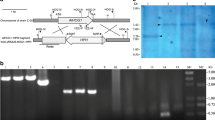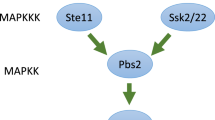Abstract
The high-osmolarity glycerol (HOG) pathway is one of the several MAP kinase cascades in fungi. It is the main signal transduction system that is responsible for cellular stress responses, and has primarily been studied in the context of osmotic stress. In the present study, we provide the first insights into the HOG pathway of the obligatory halophilic basidiomycetous fungus Wallemia ichthyophaga, with the characterisation of its two Hog1-like kinases: WiHog1A and WiHog1B. These share high similarity to Hog1 kinase from Saccharomyces cerevisiae (ScHog1) at the level of amino-acid sequence. While WiHog1A could not optimally complement the function of ScHog1, WiHog1B was a fully functional Hog1-like kinase and could improve the halotolerance of the yeast, compared to the wild-type or the ScHog1-expressing hog1Δ strain. In W. ichthyophaga cells, Hog1 was constitutively phosphorylated under optimal osmotic conditions and dephosphorylated when the cells were challenged with hypo-osmolar or hyperosmolar stress. This pattern of phosphorylation kinetics is opposite to that of yeast. Transcriptional analysis of these two kinases in W. ichthyophaga shows that WiHOG1B is more responsive to changes in NaCl concentrations than WiHOG1A. Our identification and characterisation of these Hog1-like kinases from W. ichthyophaga confirm the existence of the HOG signalling pathway and its role in osmosensing in this halophilic fungus.





Similar content being viewed by others
Abbreviations
- HOG:
-
High-osmolarity glycerol
- ScHog1:
-
Saccharomyces cerevisiae Hog1
- HwHog1:
-
Hortaea werneckii Hog1
- WiHog1A:
-
Wallemia ichthyophaga Hog1 isoform A
- WiHog1B:
-
Wallemia ichthyophaga Hog1 isoform B
- EXF:
-
Culture collection of the Department of Biology, Biotechnical Faculty, University of Ljubljana
- YNB:
-
Yeast nitrogen base
- WT:
-
Wild type
- EV:
-
Empty vector
- LG model:
-
Le-Gascuel model
References
Anisimova M, Gascuel O (2006) Approximate likelihood-ratio test for branches: a fast, accurate, and powerful alternative. Syst Biol 55:539–552
Bahn YS, Kojima K, Cox GM, Heitman J (2005) Specialization of the HOG pathway and its impact on differentiation and virulence of Cryptococcus neoformans. Mol Biol Cell 16:2285–2300
Bahn YS, Geunes-Boyer S, Heitman J (2007) Ssk2 mitogen-activated protein kinase kinase kinase governs divergent patterns of the stress-activated Hog1 signaling pathway in Cryptococcus neoformans. Eukaryot Cell 6:2278–2289
Bell M, Engelberg D (2003) Phosphorylation of Tyr-176 of the yeast MAPK Hog1/p38 is not vital for Hog1 biological activity. J Biol Chem 278:14603–14606
Bell M, Capone R, Pashtan I, Levitzki A, Engelberg D (2001) Isolation of hyperactive mutants of the MAPK p38/Hog1 that are independent of MAPK kinase activation. J Biol Chem 276:25351–25358
Brewster JL, de Valoir T, Dwyer ND, Winter E, Gustin MC (1993) An osmosensing signal transduction pathway in yeast. Science 259:1760–1763
Chen RE, Thorner J (2007) Function and regulation in MAPK signaling pathways: lessons learned from the yeast Saccharomyces cerevisiae. Biochim Biophys Acta 1773:1311–1340
de Nadal E, Alepuz PM, Posas F (2002) Dealing with osmostress through MAP kinase activation. EMBO Rep 3:735–740
Fettich M, Lenassi M, Veranic P, Gunde-Cimerman N, Plemenitas A (2011) Identification and characterization of putative osmosensors, HwSho1A and HwSho1B, from the extremely halotolerant black yeast Hortaea werneckii. Fungal Genet Biol 48:475–484
Furukawa K, Hoshi Y, Maeda T, Nakajima T, Abe K (2005) Aspergillus nidulans HOG pathway is activated only by two-component signalling pathway in response to osmotic stress. Mol Microbiol 56:1246–1261
Gietz RD, Schiestl RH (2007) Quick and easy yeast transformation using the LiAc/SS carrier DNA/PEG method. Nat Protoc 2:35–37
Gostincar C, Lenassi M, Gunde-Cimerman N, Plemenitas A (2011) Fungal adaptation to extremely high salt concentrations. Adv Appl Microbiol 77(77):71–96
Gottlich E, deHoog GS, Yoshida S, Takeo K, Nishimura K, Miyaji M (1995) Cell-surface hydrophobicity and lipolysis as essential factors in human Tinea nigra. Mycoses 38:489–494
Guindon S, Dufayard JF, Lefort V, Anisimova M, Hordijk W, Gascuel O (2010) New algorithms and methods to estimate maximum-likelihood phylogenies: assessing the performance of PhyML 3.0. Syst Biol 59:307–321
Gunde-Cimerman N, Zalar P, de Hoog S, Plemenitas A (2000) Hypersaline waters in salterns—natural ecological niches for halophilic black yeasts. FEMS Microbiol Ecol 32:235–240
Gunde-Cimerman N, Ramos J, Plemenitas A (2009) Halotolerant and halophilic fungi. Mycol Res 113:1231–1241
Gustin MC, Albertyn J, Alexander M, Davenport K (1998) MAP kinase pathways in the yeast Saccharomyces cerevisiae. Microbiol Mol Biol Rev 62:1264–1300
Han KH, Prade RA (2002) Osmotic stress-coupled maintenance of polar growth in Aspergillus nidulans. Mol Microbiol 43:1065–1078
Heermann R, Jung K (2004) Structural features and mechanisms for sensing high osmolarity in microorganisms. Curr Opin Microbiol 7:168–174
Hohmann S, Krantz M, Nordlander B (2007) Yeast osmoregulation. Methods Enzymol 428:29–45
Kondrashov FA, Rogozin IB, Wolf YI, Koonin EV (2002) Selection in the evolution of gene duplications. Genome Biol 3:1–9
Kralj Kuncic M, Kogej T, Drobne D, Gunde-Cimerman N (2010) Morphological response of the halophilic fungal genus Wallemia to high salinity. Appl Environ Microbiol 76:329–337
Krantz M, Becit E, Hohmann S (2006a) Comparative analysis of HOG pathway proteins to generate hypotheses for functional analysis. Curr Genet 49:152–165
Krantz M, Becit E, Hohmann S (2006b) Comparative genomics of the HOG-signalling system in fungi. Curr Genet 49:137–151
Lenassi M, Plemenitas A (2007) Novel group VII histidine kinase HwHhk7B from the halophilic fungi Hortaea werneckii has a putative role in osmosensing. Curr Genet 51:393–405
Lenassi M, Vaupotic T, Gunde-Cimerman N, Plemenitas A (2007) The MAP kinase HwHog1 from the halophilic black yeast Hortaea werneckii: coping with stresses in solar salterns. Saline Systems 3:3
Lenassi M, Zajc J, Gostincar C, Gorjan A, Gunde-Cimerman N, Plemenitas A (2011) Adaptation of the glycerol-3-phosphate dehydrogenase Gpd1 to high salinities in the extremely halotolerant Hortaea werneckii and halophilic Wallemia ichthyophaga. Fungal Biol 115:959–970
Maayan I, Beenstock J, Marbach I, Tabachnick S, Livnah O, Engelberg D (2012) Osmostress induces autophosphorylation of Hog1 via a C-terminal regulatory region that is conserved in p38alpha. PLoS ONE 7:e44749
Maeda T, Wurglermurphy SM, Saito H (1994) A 2-component system that regulates an osmosensing map kinase cascade in yeast. Nature 369:242–245
Mas G, de Nadal E, Dechant R, Rodriguez de la Concepcion ML, Logie C, Jimeno-Gonzalez S, Chavez S, Ammerer G, Posas F (2009) Recruitment of a chromatin remodelling complex by the Hog1 MAP kinase to stress genes. EMBO J 28:326–336
Miller JH (1972) Experiments in molecular genetics. Cold Spring Harbor Laboratory Press, Cold Spring Harbor
Murakami Y, Tatebayashi K, Saito H (2008) Two adjacent docking sites in the yeast Hog1 mitogen-activated protein (MAP) kinase differentially interact with the Pbs2 MAP kinase kinase and the Ptp2 protein tyrosine phosphatase. Mol Cell Biol 28:2481–2494
Notredame C, Higgins DG, Heringa J (2000) T-Coffee: a novel method for fast and accurate multiple sequence alignment. J Mol Biol 302:205–217
O’Rourke SM, Herskowitz I (1998) The Hog1 MAPK prevents cross talk between the HOG and pheromone response MAPK pathways in Saccharomyces cerevisiae. Genes Dev 12:2874–2886
Padamsee M, Kumar TK, Riley R, Binder M, Boyd A, Calvo AM, Furukawa K, Hesse C, Hohmann S, James TY, LaButti K, Lapidus A, Lindquist E, Lucas S, Miller K, Shantappa S, Grigoriev IV, Hibbett DS, McLaughlin DJ, Spatafora JW, Aime MC (2012) The genome of the xerotolerant mold Wallemia sebi reveals adaptations to osmotic stress and suggests cryptic sexual reproduction. Fungal Genet Biol 49:217–226
Petelenz-Kurdziel E, Eriksson E, Smedh M, Beck C, Hohmann S, Goksor M (2011) Quantification of cell volume changes upon hyperosmotic stress in Saccharomyces cerevisiae. Integr Biol (Camb) 3:1120–1126
Plemenitas A, Vaupotic T, Lenassi M, Kogej T, Gunde-Cimerman N (2008) Adaptation of extremely halotolerant black yeast Hortaea werneckii to increased osmolarity: a molecular perspective at a glance. Stud Mycol 61:67–75
Reiser V, Ruis H, Ammerer G (1999) Kinase activity-dependent nuclear export opposes stress-induced nuclear accumulation and retention of Hog1 mitogen-activated protein kinase in the budding yeast Saccharomyces cerevisiae. Mol Biol Cell 10:1147–1161
Reyes G, Romans A, Nguyen CM, May GS (2006) Novel mitogen-activated protein kinase MpkC of Aspergillus fumigatus is required for utilization of polyalcohol sugars. Eukaryot Cell 5:1934–1940
Rizner TL, Moeller G, Thole HH, Zakelj-Mavric M, Adamski J (1999) A novel 17 beta-hydroxysteroid dehydrogenase in the fungus Cochliobolus lunatus: new insights into the evolution of steroid-hormone signalling. Biochem J 337:425–431
Rozman D, Komel R (1994) Isolation of genomic DNA from filamentous fungi with high glucan level. Biotechniques 16:382–384
Saito H (2010) Regulation of cross-talk in yeast MAPK signaling pathways. Curr Opin Microbiol 13:677–683
Schneider CA, Rasband WS, Eliceiri KW (2012) NIH Image to ImageJ: 25 years of image analysis. Nat Methods 9:671–675
Sole C, Nadal-Ribelles M, Kraft C, Peter M, Posas F, de Nadal E (2011) Control of Ubp3 ubiquitin protease activity by the Hog1 SAPK modulates transcription upon osmostress. EMBO J 30:3274–3284
Tanoue T, Nishida E (2003) Molecular recognitions in the MAP kinase cascades. Cell Signal 15:455–462
Turk M, Plemenitas A (2002) The HOG pathway in the halophilic black yeast Hortaea werneckii: isolation of the HOG1 homolog gene and activation of HwHog1p. FEMS Microbiol Lett 216:193–199
Vaupotic T, Plemenitas A (2007) Differential gene expression and Hog1 interaction with osmoresponsive genes in the extremely halotolerant black yeast Hortaea werneckii. BMC Genomics 8:280
Waterhouse AM, Procter JB, Martin DM, Clamp M, Barton GJ (2009) Jalview Version 2–a multiple sequence alignment editor and analysis workbench. Bioinformatics 25:1189–1191
Westfall PJ, Thorner J (2006) Analysis of mitogen-activated protein kinase signaling specificity in response to hyperosmotic stress: use of an analog-sensitive HOG1 allele. Eukaryot Cell 5:1215–1228
Westfall PJ, Ballon DR, Thorner J (2004) When the stress of your environment makes you go HOG wild. Science 306:1511–1512
Westfall PJ, Patterson JC, Chen RE, Thorner J (2008) Stress resistance and signal fidelity independent of nuclear MAPK function. Proc Natl Acad Sci USA 105:12212–12217
Wilkins MR, Gasteiger E, Bairoch A, Sanchez JC, Williams KL, Appel RD, Hochstrasser DF (1999) Protein identification and analysis tools in the ExPASy server. Methods Mol Biol 112:531–552
Wu XC, Chi XQ, Wang PM, Zheng DQ, Ding R, Li YD (2010) The evolutionary rate variation among genes of HOG-signaling pathway in yeast genomes. Biol Direct 5:46
Xue T, Nguyen CK, Romans A, May GS (2004) A mitogen-activated protein kinase that senses nitrogen regulates conidial germination and growth in Aspergillus fumigatus. Eukaryot Cell 3:557–560
Zalar P, Sybren de Hoog G, Schroers HJ, Frank JM, Gunde-Cimerman N (2005) Taxonomy and phylogeny of the xerophilic genus Wallemia (Wallemiomycetes and Wallemiales, cl. et ord. nov.). Antonie Van Leeuwenhoek 87:311–328
Acknowledgments
The authors gratefully thank Metka Lenassi, Cene Gostinčar, Anja Kejžar and Jernej Praprotnik for their useful suggestions. This work was supported in part by Research Grant P1-0170, and in part by a Young Researcher Fellowship, from the Slovenian Research Agency.
Author information
Authors and Affiliations
Corresponding author
Additional information
Communicated by S. Albers.
Rights and permissions
About this article
Cite this article
Konte, T., Plemenitas, A. The HOG signal transduction pathway in the halophilic fungus Wallemia ichthyophaga: identification and characterisation of MAP kinases WiHog1A and WiHog1B. Extremophiles 17, 623–636 (2013). https://doi.org/10.1007/s00792-013-0546-4
Received:
Accepted:
Published:
Issue Date:
DOI: https://doi.org/10.1007/s00792-013-0546-4




